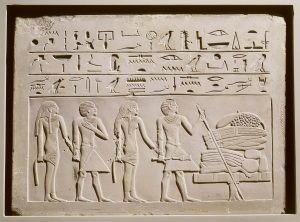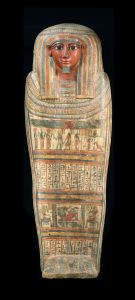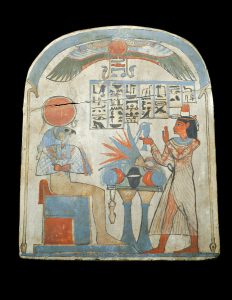
Remarkable objects from a world-inspiring culture form part of a new exhibition, Discovering Ancient Egypt, from the National Museum of Antiquities (RMO), in Leiden, the Netherlands, which is touring Australia as part of a major collaboration between the National Museum of Australia, the Western Australian Museum and the Queensland Museum Network.
The highly anticipated Discovering Ancient Egypt exhibition features more than 200 objects exploring the ancient culture’s vast social and traditional history spanning 3000 years. Through exquisite jewellery, sculpture, pottery and an array of stunning funerary material, this exhibition showcases the ancient Egyptians’ unique outlook on life and death, religious practices, daily life and the journey to the afterlife.

A unique aspect of this exhibition is its focus on the history of discovery, inviting visitors to consider the ongoing role of museums in documenting and presenting ancient cultures. Key moments such as the finding of the Rosetta Stone during Napoleon’s military campaign to Egypt and the rediscovery of the tomb of the young pharaoh Tutankhamun will be explored alongside the RMO’s prolific archaeological discoveries over decades.

The exhibition includes multimedia presentations featuring the faces and voices of local Egyptian archaeologists and cultural custodians at dig sites, ensuring visitors understand discovery as an ongoing practice.
A notable moment for visitors will be the life-sized replica facade of the Temple of Taffeh, which will be illuminated by a striking, large-scale graphic presentation. This ancient Nubian temple was shipped to the RMO from the Nile as a gift from Egypt to the Netherlands.

For this exhibition, recent CT scans have been conducted on mummified human and animal remains, with the results of the analysis being made public in Australia for the first time via a captivating digital interactive. The mummified human remains coming to Australia are preserved within their original linen bandages.
Discovering Ancient Egypt opened at the WA Museum Boola Bardip on 10 June and will travel to the National Museum in Canberra (15 December 2023 – 8 September 2024), before concluding its Australian tour at the Queensland Museum Network (25 October 2024 – 5 May 2025).
National Museum of Australia Director, Dr Mathew Trinca, said the partnership between the four museums was a credit to the arts and culture industry across Australia and further cemented Australia on the global cultural touring exhibition map.
“I particularly want to thank the Dutch National Museum of Antiquities and the Australian partner institutions. Meaningful collaboration like this enables cultural institutions to pool and leverage their resources to bring world-class exhibitions to Australia,” Dr Trinca said.
“We are delighted by the opportunity to offer Australian audiences a chance to engage with ancient Egyptian history in new ways while considering how the ongoing work of archaeologists and museum professionals continues to illuminate new information and knowledge about this intriguing ancient culture,” Dr Trinca said.
Western Australian Museum CEO, Alec Coles OBE, said the Western Australian Museum was delighted to be the first venue for this exquisite exhibition in Australia and echoed Dr Trinca’s pride in the significant relationship between the four partner museums.
“I know audiences will be mesmerised by the stories of life and death as understood by ancient Egyptians and by the highly stylised funerary art, amulets, shabti and a huge collection of objects from everyday life featured in this exhibition,” Mr Coles said.
“It is an honour to be able to present material from such a rich period of human history and from such a world-renowned collection as that of the Dutch National Museum of Antiquities.”
Queensland Museum Network CEO, Dr Jim Thompson, said Queensland Museum is thrilled to be hosting the final exhibition of this historic tour in 2024.
“This exhibition serves as a powerful testament to the enduring legacy of an ancient civilisation and the important contribution museums play in continuing engagement and dialogue around cultures and human history,” Dr Thompson said.
“We are honoured to share these remarkable cultural treasures of ancient Egypt from the Dutch National Museum of Antiquities with Queensland.”
Director of the National Museum of Antiquities, Dr Wim Weijland, said this exhibition presents many masterpieces from the RMO’s world-famous collection.
“We are delighted to be partnering with three outstanding museums. It has been inspiring to see the dedication, passion and enthusiasm that our Australian colleagues have brought to transforming this exhibition into something truly unique and exemplary,” Dr Weijland said.
Some of the highlights in the exhibition include the first sheet of a long papyrus scroll that the priest Padikhonsu took to his tomb to ensure his passage into the afterlife; a necklace with a centrepiece depicting the head of a ram, a symbol for Amun ‘the king of gods’; and the outer coffin of the priest Panesy, which is adorned on each side with depictions of the sons of Horus.
The Discovering Ancient Egypt exhibition is supported by the Australian Government International Exhibitions Insurance (AGIEI) Program. This program provides funding for the purchase of insurance for significant cultural exhibitions. Without AGIEI, the high cost of insuring significant cultural items would prohibit this major exhibition from touring Australia.
Tickets for the National Museum of Australia exhibition will go on sale later this year.
Exhibition dates
Western Australian Museum, Perth, 10 June to 8 October 2023
National Museum of Australia, Canberra, 15 December 2023 to 8 September 2024
Queensland Museum, 25 October 2024 to 5 May 2025
Source- nma.gov.au, 2 August 2023.



